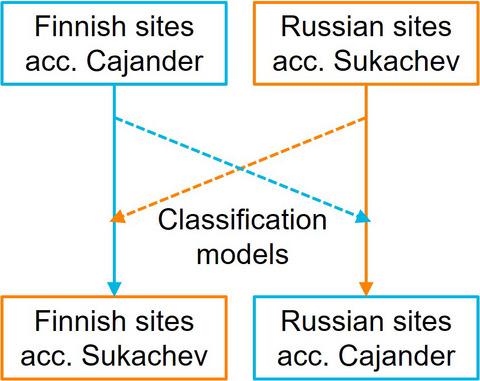当前位置:
X-MOL 学术
›
Appl. Veg. Sci.
›
论文详情
Our official English website, www.x-mol.net, welcomes your feedback! (Note: you will need to create a separate account there.)
Site types revisited: Comparison of traditional Russian and Finnish classification systems for European boreal forests
Applied Vegetation Science ( IF 2.8 ) Pub Date : 2020-08-20 , DOI: 10.1111/avsc.12525 Tähti Pohjanmies 1 , Nadezhda Genikova 2 , Juha‐Pekka Hotanen 3 , Hannu Ilvesniemi 1 , Alexander Kryshen 2 , Sergey Moshnikov 2 , Jari Oksanen 4 , Maija Salemaa 1 , Elena Tikhonova 5 , Tiina Tonteri 1 , Päivi Merilä 6
Applied Vegetation Science ( IF 2.8 ) Pub Date : 2020-08-20 , DOI: 10.1111/avsc.12525 Tähti Pohjanmies 1 , Nadezhda Genikova 2 , Juha‐Pekka Hotanen 3 , Hannu Ilvesniemi 1 , Alexander Kryshen 2 , Sergey Moshnikov 2 , Jari Oksanen 4 , Maija Salemaa 1 , Elena Tikhonova 5 , Tiina Tonteri 1 , Päivi Merilä 6
Affiliation

|
Forest classifications are tools used in research, monitoring, and management. In Finland, the Cajanderian forest site type classification is based on the composition of understorey vegetation with the assumption that it reflects in a predictable way the site's productive value. In Russia, the Sukachevian forest classification is similarly based on understorey vegetation but also accounts for tree species, soil wetness, and paludification. Here we ask whether Cajander's and Sukachev's forest types are effectively the same in terms of species composition, site productivity, and biodiversity.
中文翻译:

再次探讨场地类型:比较俄罗斯和芬兰对欧洲北方森林的传统分类系统
森林分类是用于研究,监测和管理的工具。在芬兰,Cajanderian森林用地类型分类基于底层植被的组成,并假设其以可预测的方式反映了该地的生产价值。在俄罗斯,Sukachevian森林的分类类似地基于林下植被,但也解释了树种,土壤湿度和Paludification。在这里,我们要问的是,Cajander和Sukachev的森林类型在物种组成,站点生产力和生物多样性方面是否有效相同。
更新日期:2020-08-20
中文翻译:

再次探讨场地类型:比较俄罗斯和芬兰对欧洲北方森林的传统分类系统
森林分类是用于研究,监测和管理的工具。在芬兰,Cajanderian森林用地类型分类基于底层植被的组成,并假设其以可预测的方式反映了该地的生产价值。在俄罗斯,Sukachevian森林的分类类似地基于林下植被,但也解释了树种,土壤湿度和Paludification。在这里,我们要问的是,Cajander和Sukachev的森林类型在物种组成,站点生产力和生物多样性方面是否有效相同。



























 京公网安备 11010802027423号
京公网安备 11010802027423号